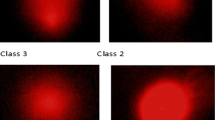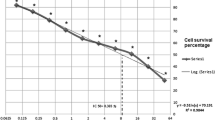Abstract
Complex industrial discharges pose certain risks to the ecosystem. This study was aimed at identifying acute and sub-chronic toxicological effects of the textile industry wastewater. The textile wastewater was evaluated for the metals and organic pollutants by atomic absorption spectrophotometer and GC-MS respectively. In vitro genotoxicity and mutagenicity were assessed by Comet assay in peripheral lymphocytes isolated from Ovis aries and Ames test in Salmonella typhimurium strains TA-100 and 102 respectively. Physiological and behavioral changes along with systemic toxicity were determined in Rattus norvegicus albinus following acute and sub-chronic exposure. High amount of heavy metals such as Cr, Pb, Hg, As, and Cd were detected in textile wastewater. Organic pollutants such as 25-deacetoxy cucurbitacin-b, E-14-Hexadecenal, 11-Tricosene, and phthalates were also found. In vitro genotoxicity assessment in lymphocytes showed statistically significant DNA damaging potential of textile wastewater. Textile wastewater also showed significantly higher (p˂ 0.05) mutagenic potential in Salmonella TA-100 and TA-102 strains than sodium azide and 2-amino anthracycline. Acute exposure of textile wastewater to Rattus norvegicus was associated with several physiological changes and behavioral symptoms. Sub-chronic exposure of textile wastewater in Rattus norvegicus instigated the degeneration and necrosis of epithelial cells in renal tubules, hydropic degeneration and necrosis of hepatocytes, peri-bronchiolar infiltration and emphysema of the alveoli, and the degradation of myocardial cells. This study concludes that the textile wastewater may cause genotoxicity and mutagenicity, result in physiological and behavioral changes upon acute exposure, and inflict various pathological lesions upon sub-chronic exposure.



Similar content being viewed by others
References
Akhtar, M. F., Ashraf, M., Anjum, A. A., Javeed, A., Sharif, A., Saleem, A., & Akhtar, B. (2016). Textile industrial effluent induces mutagenicity and oxidative DNA damage and exploits oxidative stress biomarkers in rats. Environmental Toxicology and Pharmacology, 41, 180–186. https://doi.org/10.1016/j.etap.2015.11.022.
Akhtar, M. F., Ashraf, M., Javeed, A., Anjum, A. A., Sharif, A., Saleem, A., Akhtar, B., Khan, A. M., & Altaf, I. (2016a). Toxicity appraisal of untreated dyeing industry wastewater based on chemical characterization and short term bioassays. Bulletin of Environmental Contamination and Toxicology, 96(4), 502–507.
Akhtar, M. F., Saleem, A., Sharif, A., Akhtar, B., Nasim, M. B., Peerzada, S., Raza, M., Ijaz, H., Ahmed, S., Shabbir, M., Ali, S., Akbar, Z., & Ul Hassan, S. S. (2016b). Genotoxic and cytotoxic action potential of Terminalia citrina, a medicinal plant of ethnopharmacological significance. EXCLI Journal, 15, 589–598. https://doi.org/10.17179/excli2016-551.
Akhtar, M. F., Sharif, A., Saleem, M., Saleem, A., Akhtar, B., Raza, M., Ijaz, H., Shabbir, M., Ali, S., Sharif, A., Nasim, M. B., & Peerzada, S. (2017). Genotoxic and cytotoxic potential of Alternanthera Bettzickiana, an important ethno-medicinal plant. Cellular and Molecular Biology (Noisy-le-Grand, France), 63(8), 109–114.
Alam, M. Z., Ahmad, S., Malik, A., & Ahmad, M. (2010). Mutagenicity and genotoxicity of tannery effluents used for irrigation at Kanpur, India. Ecotoxicology and Environmental Safety, 73(7), 1620–1628.
Ali, D., Nagpure, N. S., Kumar, S., Kumar, R., & Kushwaha, B. (2008). Genotoxicity assessment of acute exposure of chlorpyrifos to freshwater fish Channa punctatus (Bloch) using micronucleus assay and alkaline single-cell gel electrophoresis. Chemosphere, 71(10), 1823–1831. https://doi.org/10.1016/j.chemosphere.2008.02.007.
Ali, N., Hameed, A., & Ahmed, S. (2009). Physicochemical characterization and bioremediation perspective of textile effluent, dyes and metals by indigenous bacteria. Journal of Hazardous Materials, 164(1), 322–328. https://doi.org/10.1016/j.jhazmat.2008.08.006.
Allen, H. E., & Hansen, D. J. (1996). The importance of trace metal speciation to water quality criteria. Water Environment Research, 68(1), 42–54. https://doi.org/10.2175/106143096x127307.
Apaydın, F. G., Baş, H., Kalender, S., & Kalender, Y. (2016). Subacute effects of low dose lead nitrate and mercury chloride exposure on kidney of rats. Environmental Toxicology and Pharmacology, 41, 219–224. https://doi.org/10.1016/j.etap.2015.12.003.
Avagyan, R., Luongo, G., Thorsén, G., & Östman, C. (2015). Benzothiazole, benzotriazole, and their derivates in clothing textiles—a potential source of environmental pollutants and human exposure. Environmental Science and Pollution Research, 22(8), 5842–5849. https://doi.org/10.1007/s11356-014-3691-0.
Barbouti, A., Doulias, P.-T., Zhu, B.-Z., Frei, B., & Galaris, D. (2001). Intracellular iron, but not copper, plays a critical role in hydrogen peroxide-induced DNA damage. Free Radical Biology and Medicine, 31(4), 490–498. https://doi.org/10.1016/S0891-5849(01)00608-6.
Ding, W., Hudson, L. G., & Liu, K. J. (2005). Inorganic arsenic compounds cause oxidative damage to DNA and protein by inducing ROS and RNS generation in human keratinocytes. Molecular and Cellular Biochemistry, 279(1–2), 105–112.
Dsikowitzky, L., & Schwarzbauer, J. (2014). Industrial organic contaminants: identification, toxicity and fate in the environment. Environmental Chemistry Letters, 12(3), 371–386. https://doi.org/10.1007/s10311-014-0467-1.
Ejaz, S., Camer, G. A., Anwar, K., & Ashraf, M. (2014). Monitoring impacts of air pollution: PIXE analysis and histopathological modalities in evaluating relative risks of elemental contamination. Ecotoxicology, 23(3), 357–369.
García-Lestón, J., Méndez, J., Pásaro, E., & Laffon, B. (2010). Genotoxic effects of lead: an updated review. Environment International, 36(6), 623–636.
Haley, J. E., & Dickenson, A. H. (2016). Evidence for spinal N-methyl-D-aspartate receptor involvement in prolonged chemical nociception in the rat. Brain research.
Hemachandra, C., & Pathiratne, A. (2015). Assessing toxicity of copper, cadmium and chromium levels relevant to discharge limits of industrial effluents into inland surface waters using common onion, Allium cepa bioassay. Bulletin of Environmental Contamination and Toxicology, 94(2), 199–203. https://doi.org/10.1007/s00128-014-1373-8.
Lee, D. H., O’Connor, T. R., & Pfeifer, G. P. (2002). Oxidative DNA damage induced by copper and hydrogen peroxide promotes CG→ TT tandem mutations at methylated CpG dinucleotides in nucleotide excision repair-deficient cells. Nucleic Acids Research, 30(16), 3566–3573. https://doi.org/10.1093/nar/gkf478.
Lynch, J. J., Castagné, V., Moser, P. C., & Mittelstadt, S. W. (2011). Comparison of methods for the assessment of locomotor activity in rodent safety pharmacology studies. Journal of Pharmacological and Toxicological Methods, 64(1), 74–80.
Marin, M. (2011). The use of the cytogenetic to identify mechanisms of action of an azo dye in Allium cepa meristematic cells. Journal of Environmental & Analytical Toxicology.
Mathur, N., Bhatnagar, P., Mohan, K., Bakre, P., Nagar, P., & Bijarnia, M. (2007). Mutagenicity evaluation of industrial sludge from common effluent treatment plant. Chemosphere, 67(6), 1229–1235.
Mortelmans, K., & Zeiger, E. (2000). The Ames salmonella/microsome mutagenicity assay. Mutat Res Fundam Mol Mech Mutagen, 455(1–2), 29–60. https://doi.org/10.1016/S0027-5107(00)00064-6.
Ormad, M., Miguel, N., Claver, A., Matesanz, J., & Ovelleiro, J. (2008). Pesticides removal in the process of drinking water production. Chemosphere, 71(1), 97–106. https://doi.org/10.1016/j.chemosphere.2007.10.006.
Rajaguru, P., Vidya, L., Baskarasethupathi, B., Kumar, P. A., Palanivel, M., & Kalaiselvi, K. (2002). Genotoxicity evaluation of polluted ground water in human peripheral blood lymphocytes using the comet assay. Mutat Res Genet Toxicol Environ Mutagen, 517(1–2), 29–37. https://doi.org/10.1016/S1383-5718(02)00025-6.
Rovira, J., Nadal, M., Schuhmacher, M., & Domingo, J. L. (2015). Human exposure to trace elements through the skin by direct contact with clothing: Risk assessment. Environmental Research, 140, 308–316. https://doi.org/10.1016/j.envres.2015.03.032.
Salama, H. M. (2012). Alkaloids and flavonoids from the air dried aerial parts of Citrullus colocynthis. J Med Plant Res, 6(38), 5150–5155. https://doi.org/10.5897/JMPR12.406.
Sankar, P., Telang, A. G., Kalaivanan, R., Karunakaran, V., Suresh, S., & Kesavan, M. (2016). Oral nanoparticulate curcumin combating arsenic-induced oxidative damage in kidney and brain of rats. Toxicology and Industrial Health, 32(3), 410–421. https://doi.org/10.1177/0748233713498455.
Sany, S. B. T., Hashim, R., Rezayi, M., Rahman, M. A., Razavizadeh, B. B. M., Abouzari-lotf, E., et al. (2015). Integrated ecological risk assessment of dioxin compounds. Environmental Science and Pollution Research, 22(15), 11193–11208. https://doi.org/10.1007/s11356-015-4511.
Shackelford, C., Long, G., Wolf, J., Okerberg, C., & Herbert, R. (2002). Qualitative and quantitative analysis of nonneoplastic lesions in toxicology studies. Toxicologic Pathology, 30(1), 93–96. https://doi.org/10.1080/01926230252824761.
Shakir, L., Ejaz, S., Ashraf, M., Ahmad, N., & Javeed, A. (2012). Characterization of tannery effluent wastewater by proton-induced X-ray emission (PIXE) analysis to investigate their role in water pollution. Environmental Science and Pollution Research, 19(2), 492–501. https://doi.org/10.1007/s11356-011-0586-1.
Sharif, A., Ashraf, M., Javeed, A., Anjum, A. A., Akhtar, M. F., Akhtar, B., & Saleem, A. (2016). Oxidative stress responses in Wistar rats on subacute exposure to pharmaceutical wastewater. Environmental Science and Pollution Research, 23(23), 24158–24165.
Sharma, B., Singh, S., & Siddiqi, N. J. (2014). Biomedical implications of heavy metals induced imbalances in redox systems. BioMed Research International, 2014(14), 1–7.
Singh, B. N., Singh, B., Singh, R., Prakash, D., Singh, D., Sarma, B., et al. (2009). Polyphenolics from various extracts/fractions of red onion (Allium cepa) peel with potent antioxidant and antimutagenic activities. Food and Chemical Toxicology, 47(6), 1161–1167. https://doi.org/10.1016/j.fct.2009.02.004.
Soliman, M. M., Baiomy, A. A., & Yassin, M. H. (2015). Molecular and histopathological study on the ameliorative effects of curcumin against lead acetate-induced hepatotoxicity and nephrototoxicity in Wistar rats. [journal article]. Biological Trace Element Research, 167(1), 91–102. https://doi.org/10.1007/s12011-015-0280-0.
Sörensen, P. M., Iacob, R. E., Fritzsche, M., Engen, J. R., Brieher, W. M., Charras, G., & Eggert, U. S. (2012). The natural product cucurbitacin E inhibits depolymerization of actin filaments. ACS Chemical Biology, 7(9), 1502–1508. https://doi.org/10.1021/cb300254s.
Toufexi, E., Tsarpali, V., Efthimiou, I., Vidali, M.-S., Vlastos, D., & Dailianis, S. (2013). Environmental and human risk assessment of landfill leachate: an integrated approach with the use of cytotoxic and genotoxic stress indices in mussel and human cells. Journal of Hazardous Materials, 260, 593–601. https://doi.org/10.1016/j.jhazmat.2013.05.054.
Tran, D., Moody, A. J., Fisher, A. S., Foulkes, M. E., & Jha, A. N. (2007). Protective effects of selenium on mercury-induced DNA damage in mussel haemocytes. Aquatic Toxicology, 84(1), 11–18.
Ullah, A., Ashraf, M., Javeed, A., Anjum, A. A., Attiq, A., & Ali, S. (2016). Enhancement of anti-proliferative activities of metformin, when combined with celecoxib, without increasing DNA damage. Environmental Toxicology and Pharmacology, 45, 227–234. https://doi.org/10.1016/j.etap.2016.05.017.
Verbruggen, E. (2007). Guidance for the derivation of environmental risk limits within the framework of international and national environmental quality standards for substances in the Netherlands'(INS). Revision 2007.
Waseem, A., Arshad, J., Iqbal, F., Sajjad, A., Mehmood, Z., & Murtaza, G. (2014). Pollution status of Pakistan: a retrospective review on heavy metal contamination of water, soil, and vegetables. BioMed Research International, 2014, 1–29. https://doi.org/10.1155/2014/813206.
Yang, L., Wu, S., Zhang, Q., Liu, F., & Wu, P. (2007). 23, 24-Dihydrocucurbitacin B induces G 2/M cell-cycle arrest and mitochondria-dependent apoptosis in human breast cancer cells (Bcap37). Cancer Letters, 256(2), 267–278. https://doi.org/10.1016/j.canlet.2007.06.018.
Zhang, W., Liu, W., Zhang, J., Zhao, H., Zhang, Y., Quan, X., & Jin, Y. (2012). Characterisation of acute toxicity, genotoxicity and oxidative stress posed by textile effluent on zebrafish. Journal of Environmental Sciences, 24(11), 2019–2027. https://doi.org/10.1016/S1001-0742(11)61030-9.
Zhou, D., Yang, J., Li, H., Cui, C., Yu, Y., Liu, Y., & Lin, K. (2016). The chronic toxicity of bisphenol A to Caenorhabditis elegans after long-term exposure at environmentally relevant concentrations. Chemosphere, 154, 546–551. https://doi.org/10.1016/j.chemosphere.2016.04.011.
Author information
Authors and Affiliations
Corresponding author
Ethics declarations
Conflict of interest
The authors declare that they have no competing interests.
Rights and permissions
About this article
Cite this article
Akhtar, M.F., Ashraf, M., Javeed, A. et al. Association of textile industry effluent with mutagenicity and its toxic health implications upon acute and sub-chronic exposure. Environ Monit Assess 190, 179 (2018). https://doi.org/10.1007/s10661-018-6569-7
Received:
Accepted:
Published:
DOI: https://doi.org/10.1007/s10661-018-6569-7




